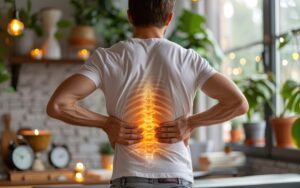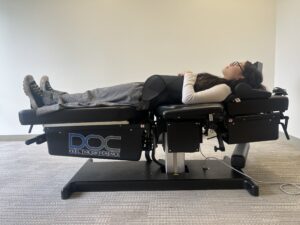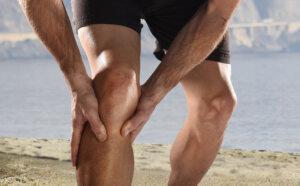
Are Dry Needling and Acupuncture the Same? If you’ve ever seen a picture of someone performing dry needling vs acupuncture, no one would blame you if you confused the two. After all, they both involve the placement of super-thin needles shallowly into the skin. Both can be used to manage pain — albeit different kinds.
But that’s the end of the similarities.
If you’d like to skip the explanations, go straight to the quiz.
What Is Dry Needling Vs Acupuncture?
What Is Dry Needling?
Dry needling is a therapeutic technique that targets trigger points on the body. This instructs specific musculoskeletal systems to “reset to default”. By doing so, they begin functioning as they were intended to.
It involves the placement of a tiny, single-use, dry needle into a trigger point. A myofascial trigger point is an easily irritated spot found on the fascia of a musculoskeletal system. Fascia is an extremely nerve-dense (and therefore sensitive) tissue that surrounds organs, bones, muscles, and other systems in the body.
Nodules and tightness can form within the fascia. A trained professional can feel these spots on your body. You can also feel them as isolated pain or tension in a muscle.
Placing a dry needle on this spot acts as a “reset button” for that network of tissues. We call it “dry needling” because the needle doesn’t inject anything into your body. The sterile, stainless steel needle instead works with your own body’s natural responses to get the desired result.
What Is Acupuncture?
Acupuncture also requires several single-use, tiny needles. The acupuncturist applies these needles shallowly to acupuncture points to restore optimal health.
Acupuncture points are not the same as the trigger points targeted with dry needling. Instead, they are points mapped out on the human body along life force (Qi or Chi) pathways called Meridians. These pathways manage the flow of Qi energy and connect everything, body-mind-emotions.
Since these are also connected, disruptions or blockages in one part of a whole person (That’s you!) can lead to dis-ease in another part of the body, mind, or emotions.
An acupuncturist targets these points by shallowly inserting needles into your external body (skin) to unblock Qi within the body (e.g., liver function) and restore balance in those energies.
So when comparing dry needling vs acupuncture, dry needling helps improve the mechanical function of the muscles and joints. Alternatively, acupuncture helps restore how energy moves through your body to promote overall health.
So much more to explore on our site! We think you’ll also like these helpful articles.
How Does Dry Acupuncture Vs Dry Needling Work?
Dry Needling Supports Musculoskeletal Balance
Your musculoskeletal system comprises muscles, bones, and connective tissues. Overuse, underuse, and misuse can cause this system to stop functioning as it initially did.
Unfortunately, modern life doesn’t promote whole body health. You use specific muscles a lot, and others hardly move. Just think of how often you use your right hand vs left hand, depending on your preference.
As a result, some systems overwork while others do not. They become weak. This creates an imbalance between them that can lead to abnormal stress. You may experience this as a localized:
- Tension
- Pain
- Pinched nerves and nerve pain
- Cramping up
If allowed to continue, this can cause degenerative joint diseases and a change in your posture. Misalignment slowly becomes the new normal. The body tries to adapt to how you’re using it.
Those who sit for 8-10 hours a day can find themselves particularly affected. Sitting muscles get stronger. Standing and moving muscles get weaker.
By targeting the myofascial trigger point, we can restore proper alignment and balance among systems.
Acupuncture Supports Optimal Health and Function
Acupuncture is a complex, and well-studied science of how Qi moves through the body. Through research and experimentation, ancient acupuncturists mapped out how Qi flows within the meridians. This allowed them to target specific acupuncture points to unblock the flow of Qi.
Keep in mind that neither acupuncture nor dry needling is a treatment in the way conventional medicine defines “treatment”. Both work by helping your body help itself. They can reset and activate your body’s natural tendency to want to restore balance and move toward optimal health. In that, dry needling and acupuncture are the same.
We can further explore the dry needling and acupuncture differences by looking at the types of conditions you might use acupuncture or dry needling for.
Take the quiz to find out which one may be better for you.
What Does Dry Needling Versus Acupuncture Help With?
Dry Needling Helps Primarily with Extremity Pain
Most pain in your extremities is caused by imbalances in the musculoskeletal systems. One system is working harder than another, overcompensating and causing strain. You may have experienced this when you’ve ever favored an injured body part and developed a cramp somewhere else because of the imbalance.
So activating the trigger points with a dry needle can help restore balance and reduce pain with conditions like these:
- Tennis elbow
- Golfer’s elbow
- Hip Pain
- Pain in the Glutes (Buttocks)
- Knee pain
- Achilles Tendonitus / Tendonosis
- Plantar Fasciitis
- Other foot pain
- Various muscle spasms
- Dry needling for TMJ
To experience the benefits of acupuncture, schedule an initial consultation for evaluation and first treatment.
Acupuncture Helps with Disrupted Qi Flow that Can Lead to Physical and Emotional Pain
Acupuncture can help with a broader range of conditions related to imbalances in the Qi flow. As a result, you may experience improvements in:
- Digestive issues
- Menstrual pain
- Autoimmune diseases
- Inability to deal with stress
- Depressed feelings
- Migraines
- General pain
- Allergies
You’ll find a more complete list here.
While dry needling vs acupuncture for various conditions may sound straightforward, everyone is different and may need one, the other, or both to experience the greatest relief. For example, many want to know about Dry Needling vs Acupuncture for migraines.
Some people who have migraine, develop a tension headache that becomes a migraine while others see light flashes that signal the headache is on its way. These are just two of the different ways people experience migraine. Each calls for a different solution. For this reason, both dry needling and acupuncture can be effective for migraines, depending on the person and how they experience the condition.
When you take the quiz, you’ll quickly learn which might work best for your unique situation.
Origins
Dry needling is a fairly recent and modern treatment first practiced in 1979. It is growing quickly in popularity and respect in the conventional medical community. In fact, many physical therapists now learn this treatment as part of their training. They are adding it to their list of therapies they use to help patients with various types of pain.
On the other hand, acupuncture is an ancient Chinese Medicine practice dating back 1000s of years that is also growing in popularity and respect in the U.S.
Relationships to Conventional Medicine
American Medical Association (AMA)
The American Medical Association (AMA) has also presented acupuncture as a possible solution when they said, “Non-pharmacologic therapy and non-opioid pharmacologic therapy are preferred for chronic pain”.
The American Medical Association (AMA) calls dry needling an invasive procedure. That term sounds scary. But it just means that because a needle penetrates the skin, only a licensed practitioner can perform it. These include medical doctors, doctors of chiropractic, physical therapists, and doctors of acupuncture. The AMA and many other organizations consider dry needling to be a type of acupuncture. So it’s important to note many may use the term “acupuncture” when they are really talking about dry needling in research and vice versa.
American Physical Therapy Association (APTA)
Similarly, the American Physical Therapy Association (APTA) says that physical therapists who are properly trained can offer this treatment to their patients.
National Institutes of Health (U.S.)
Acupuncture and dry needling have a lot of modern scientific research backing up their efficacy for a variety of ailments. According to the National Center for Complementary and Integrative Health a subset of The National Institutes of Health, “Results from a number of studies suggest that acupuncture {including dry needling} may help ease types of pain that are often chronic such as low-back pain, neck pain, and osteoarthritis/knee pain… reduce the frequency of tension headaches and prevent migraine headaches.”
Conventional medicine sees the benefits of acupuncture a little differently than a modern acupuncturist or ancient practitioner would. They recognize that acupuncture can:
- Reduce inflammation
- Stimulate blood flow
- Stimulate the nervous system
- Activate endorphins, your body’s natural painkillers
They see it as an integrative therapy complementing conventional medicine much like chiropractic or nutritional therapy. In the same way, it can work for people who are willing to stick with a treatment plan.
To experience the benefits of acupuncture, schedule an initial consultation for evaluation and first treatment.
Dry Needling Therapy Vs Acupuncture Treatment Targets
Through years of education and experience, trained professionals can feel that tension and knots when they examine a part of your body. Often the location of these knots isn’t precisely where you have pain, since these systems pull on each other.
The practitioner knows that placing a needle at that trigger point causes the muscle to release that tension so that it can start working correctly.
On the other hand, acupuncture follows a well-researched and defined meridian map. This map dictates that placing a series of needles here, here, and here can restore the proper flow of Qi. The acupuncturist listens to the client describing their problems. Then, based on their understanding of the meridian map, they know where to place the needles.
Dry Needling Vs Acupuncture: Side Effects
All procedures and therapies can have side effects. So it’s important to only allow a trained and licensed professional to perform dry needling or acupuncture. Because needles are single-use, the risk of infection is minimal. Most side effects are mild and not enough to stop someone from having either done. Around the treatment site, you may experience temporary pain, bruising, and bleeding.
To experience the benefits of acupuncture, schedule an initial consultation for evaluation and first treatment.
Take the Quiz
Are you currently experiencing pain or conditions that may be the result of imbalances and blockages in your body? Then it’s time to learn more about which service might be right for you. Take the below quiz.



